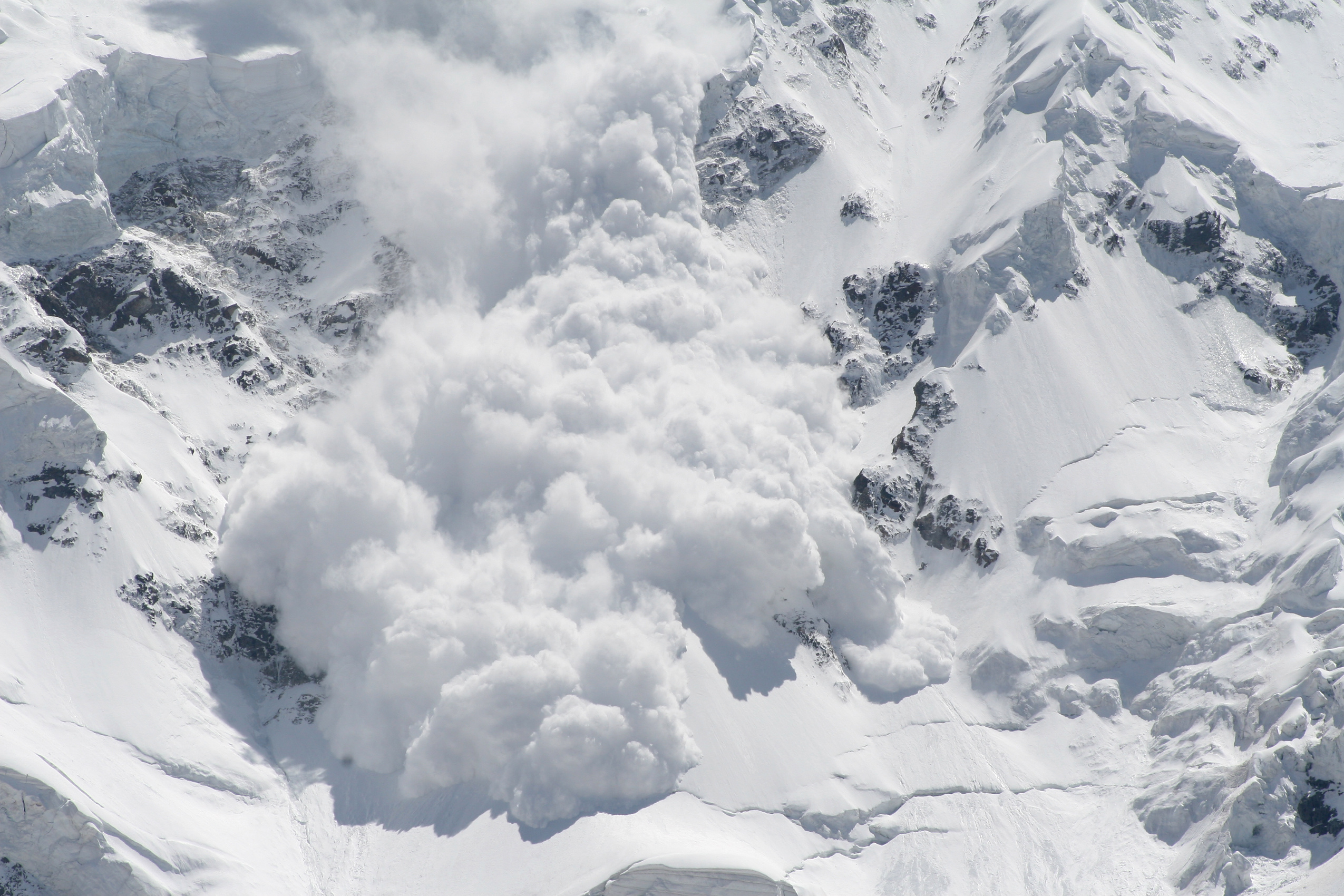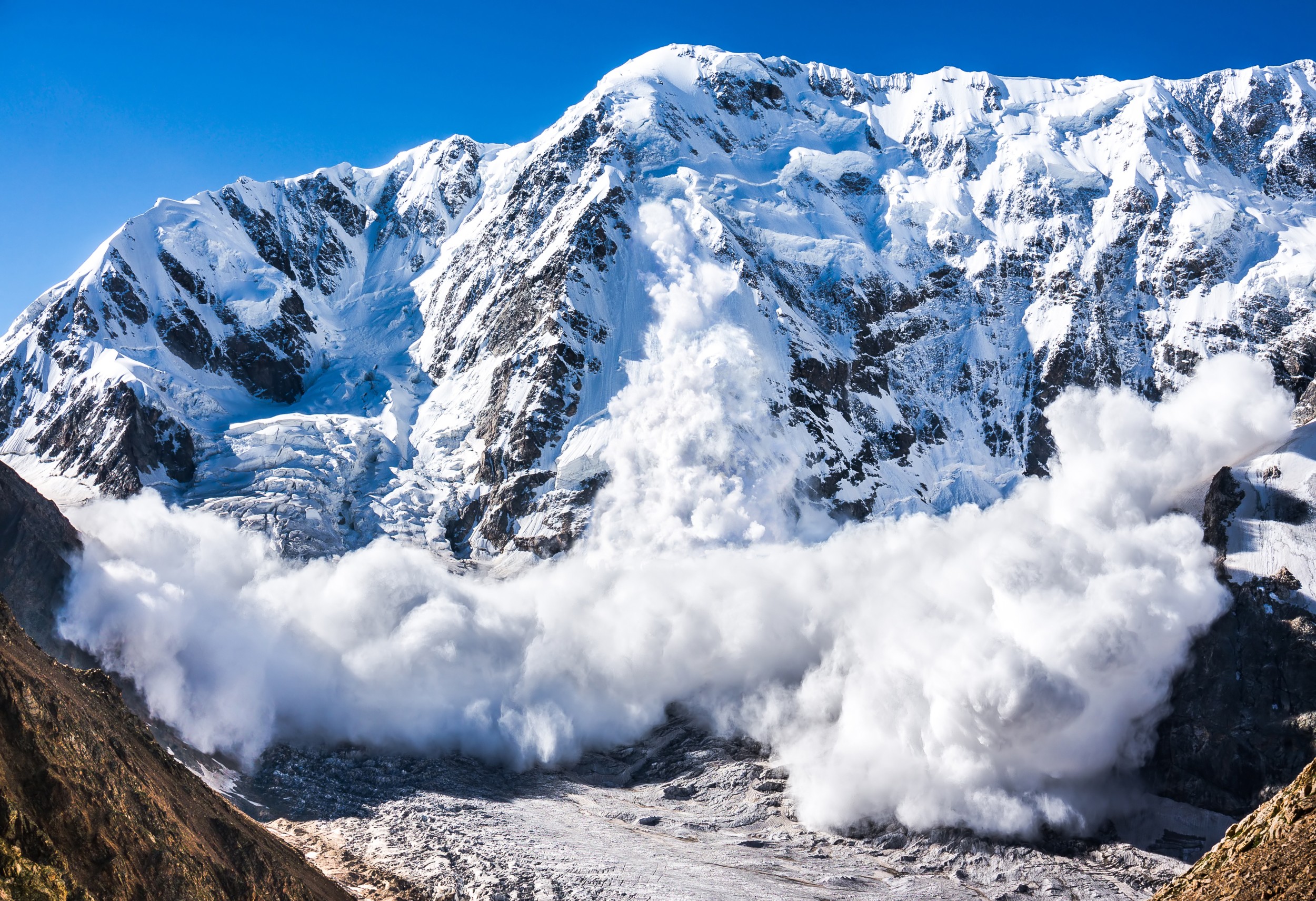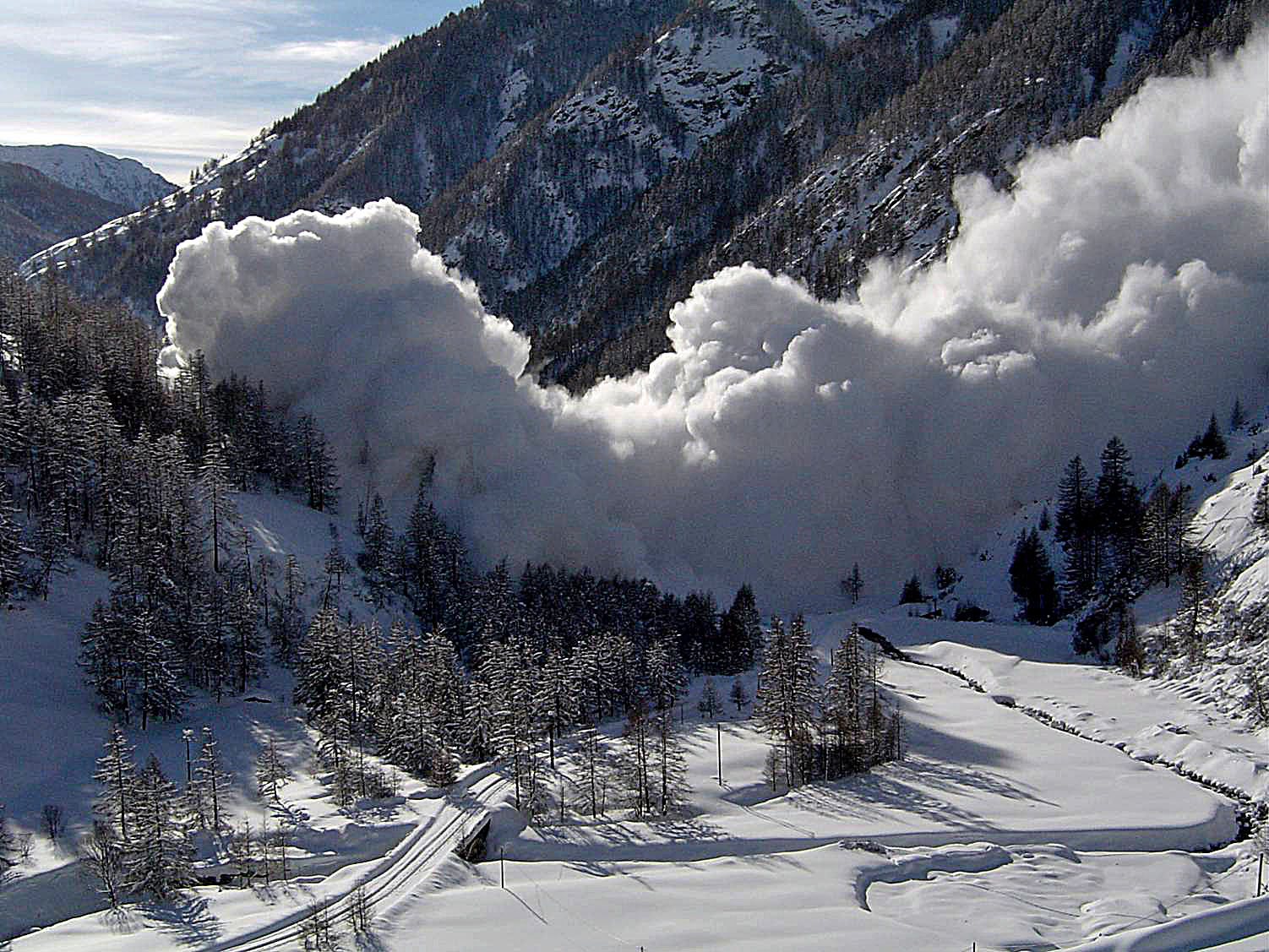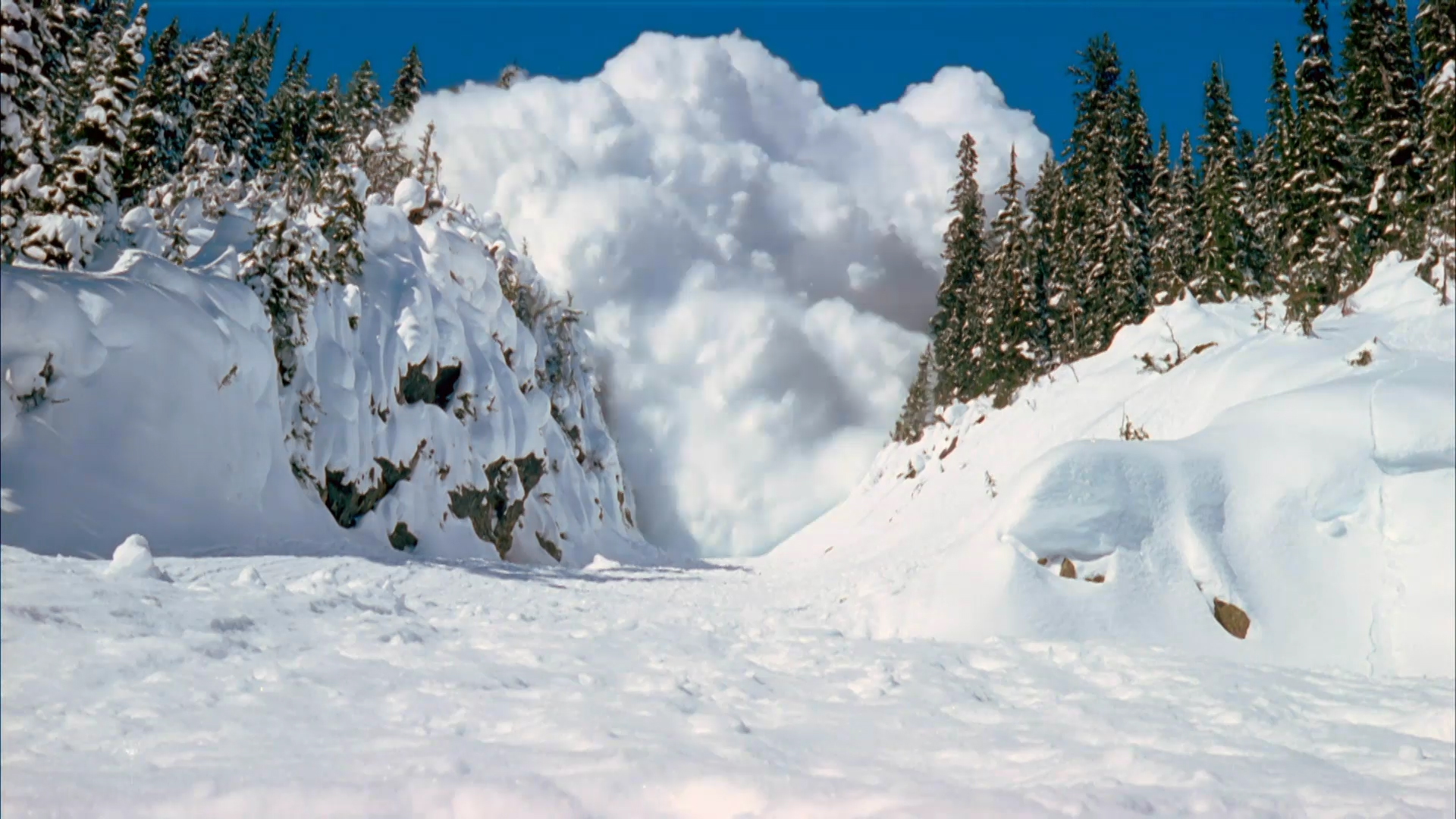Avalanche, a formidable force of nature, takes center stage in this captivating narrative. From its origins to its devastating impact, we delve into the fascinating world of snowslides, exploring their causes, dynamics, and the strategies employed to mitigate their risks.
Avalanches, triggered by a delicate interplay of snowpack instability, weather conditions, and terrain, can unleash immense power, carving paths of destruction across mountain landscapes. This intricate dance of nature’s elements sets the stage for an exploration of the science behind avalanches, their formation, and the warning signs that herald their impending arrival.
Avalanche Definition
An avalanche is a sudden, rapid flow of snow down a slope. Avalanches can be triggered by a variety of factors, including earthquakes, heavy snowfall, or human activity.
There are three main types of avalanches:
- Loose-snow avalanches are the most common type of avalanche. They occur when a layer of loose snow on the surface of a slope breaks away and slides downhill.
- Slab avalanches are less common than loose-snow avalanches, but they are much more dangerous. Slab avalanches occur when a solid slab of snow breaks away from a slope and slides downhill.
- Mixed avalanches are a combination of loose-snow and slab avalanches.
Causes of Avalanches
Avalanches are often triggered by a combination of factors that affect the stability of the snowpack. These factors include weather conditions, terrain characteristics, and human activity.
The most common cause of avalanches is the presence of a weak layer in the snowpack. This layer can be created by a variety of factors, such as a change in temperature, wind, or precipitation. When a weak layer is present, it can be easily overloaded by the weight of additional snow, causing the entire snowpack to collapse.
Weather Conditions, Avalanche
- Heavy snowfall: Rapid snowfall can overload the snowpack, especially if it is accompanied by strong winds.
- Rain: Rain can penetrate the snowpack and weaken it, making it more susceptible to avalanches.
- Wind: Wind can transport snow and create drifts, which can increase the weight and instability of the snowpack.
- Temperature changes: Rapid changes in temperature can cause the snowpack to expand and contract, which can create weak layers.
Terrain Factors
- Slope angle: Avalanches are more likely to occur on slopes that are steeper than 30 degrees.
- Terrain features: Obstacles such as trees, rocks, and cliffs can create stress points in the snowpack, increasing the risk of avalanches.
- Vegetation cover: Vegetation can help to stabilize the snowpack and reduce the risk of avalanches.
Human Activity
Human activity can also trigger avalanches. Activities such as skiing, snowboarding, and snowmobiling can overload the snowpack and cause it to collapse.
Common Warning Signs
There are a number of common warning signs that can indicate an impending avalanche, including:
- Cracking or collapsing snow: This can indicate the presence of a weak layer in the snowpack.
- Whooshing sounds: These sounds can indicate that an avalanche is about to occur.
- Sudden changes in snow conditions: This can indicate that the snowpack is becoming unstable.
Avalanche Formation
Avalanches form when a slab of snow slides down a steep slope. This can happen naturally or be triggered by human activity.
The process of avalanche formation begins with the formation of a weak layer in the snowpack. This layer can be created by a variety of factors, such as changes in temperature, wind, or precipitation.
Snowpack Layering
Snowpack is a term used to describe the layers of snow that accumulate on the ground. These layers can vary in density, temperature, and crystal structure.
The weakest layer in the snowpack is often found near the bottom, where it is subjected to the most stress. This layer is known as the “failure plane”.
Weak Layers
Weak layers are created when snow crystals are not able to bond together properly. This can happen when the snow is too warm, too cold, or too wet.
Weak layers can also be created by changes in wind direction. When the wind changes direction, it can create a layer of loose snow that is not well-bonded to the snow below.
Trigger Mechanisms
Avalanches can be triggered by a variety of factors, including:
- Natural triggers: These include earthquakes, snowstorms, and avalanches.
- Human triggers: These include skiing, snowboarding, and snowshoeing.
The most common trigger for avalanches is human activity. When a person skis or snowboards on a steep slope, they can create a shock wave that can trigger an avalanche.
Decision-Making Process for Assessing Avalanche Risk
The decision-making process for assessing avalanche risk involves a number of factors, including:
- The snowpack conditions
- The weather forecast
- The terrain
- The group’s experience and ability
By considering all of these factors, it is possible to make an informed decision about whether or not to ski or snowboard on a particular slope.
Narrative Describing a Hypothetical Avalanche Scenario
On a cold winter day, a group of skiers were backcountry skiing in the mountains. The snowpack was unstable, and there were several weak layers present.
One of the skiers triggered an avalanche when he skied over a steep slope. The avalanche swept the skiers down the mountain, and they were all buried in the snow.
The skiers were able to dig themselves out of the snow, but they were all injured. They were lucky to be alive.
This scenario is a reminder that avalanches can happen even when the snowpack seems stable. It is important to be aware of the risks and to make informed decisions about whether or not to ski or snowboard on a particular slope.
Avalanche Dynamics
Avalanches are complex phenomena involving the rapid flow of snow down a slope. The physical processes involved in avalanches include flow dynamics, impact forces, and debris deposition. These processes determine the size, velocity, and runout distance of avalanches.
Flow Dynamics
Avalanches can flow in different ways, depending on the type of avalanche and the snowpack conditions. Dry slab avalanches, which are the most common type of avalanche, typically flow as a cohesive slab of snow. Wet slab avalanches, which occur when the snowpack is wet and heavy, flow as a more fluid mass. Powder avalanches, which occur when the snowpack is dry and loose, flow as a cloud of snow particles.
Impact Forces
Avalanches can exert enormous impact forces on objects in their path. These forces can cause severe damage to buildings, infrastructure, and vegetation. The impact force of an avalanche is determined by the mass, velocity, and density of the avalanche.
Debris Deposition
Avalanches deposit debris in a variety of ways. Dry slab avalanches typically deposit their debris in a pile at the bottom of the slope. Wet slab avalanches can deposit their debris in a more fluid form, creating a debris flow. Powder avalanches can deposit their debris in a wide area, creating a snowdrift.
Avalanche Hazard Assessment
Avalanche hazard assessment is crucial for ensuring the safety of individuals in avalanche-prone areas. It involves evaluating the potential for avalanches to occur and the associated risks they pose.
Field observations, snowpack analysis, and terrain evaluation are the primary methods used for assessing avalanche hazard. Field observations involve examining the snowpack’s stability, identifying potential weak layers, and assessing the weather and wind conditions. Snowpack analysis includes measuring the snowpack’s depth, density, and crystal structure to determine its stability.
Terrain Evaluation
Terrain evaluation considers the slope angle, aspect, and vegetation cover. Steep slopes with a lack of vegetation are more susceptible to avalanches. Additionally, avalanche paths and runout zones need to be identified and mapped.
Avalanche Forecasting
Avalanche forecasting plays a vital role in hazard management. Forecasters use data from field observations, snowpack analysis, and terrain evaluation to issue avalanche advisories. These advisories provide information about the current avalanche hazard, including the likelihood of avalanches, the areas most at risk, and recommendations for safe travel in avalanche terrain.
Avalanche Risk Management
Avalanche risk management involves implementing strategies to mitigate the risks associated with avalanches. These strategies include avalanche avoidance, control measures, emergency response plans, and public education and awareness.
Avalanche avoidance involves identifying and avoiding avalanche-prone areas. This can be done through avalanche forecasting, mapping, and education. Control measures involve triggering avalanches in a controlled manner to reduce the risk of larger, uncontrolled avalanches. Emergency response plans Artikel the steps to be taken in the event of an avalanche, including evacuation procedures and search and rescue operations.
Public Education and Awareness
Public education and awareness are essential components of avalanche risk management. Educational programs can teach people about avalanche hazards, how to recognize avalanche terrain, and how to avoid avalanches. Public awareness campaigns can promote safe behavior in avalanche-prone areas.
Avalanche Rescue Techniques

Avalanche rescue is a crucial aspect of avalanche safety, involving a range of techniques employed to locate and extract victims buried under snow.
There are three primary avalanche rescue techniques:
Companion Rescue
Companion rescue involves a group of trained individuals working together to locate and rescue buried victims using avalanche transceivers, probes, and shovels.
- Avalanche transceivers emit radio signals that allow rescuers to locate buried victims.
- Probes are used to pinpoint the exact location of victims.
- Shovels are used to excavate and extract victims.
Organized Search and Rescue
Organized search and rescue operations involve trained professionals using advanced equipment and techniques to locate and rescue buried victims.
- Avalanche rescue dogs are highly trained to locate buried victims by scent.
- Helicopters are used to transport rescuers and equipment to remote areas and evacuate victims.
Helicopter Operations
Helicopter operations are often used in avalanche rescue due to their speed and ability to access remote areas.
Expand your understanding about Miranda Sarmento with the sources we offer.
- Helicopters can transport rescuers and equipment to the avalanche site quickly.
- They can also be used to evacuate victims and transport them to medical facilities.
- However, helicopter operations in avalanche rescue can be challenging and risky due to the unpredictable nature of avalanches and the often harsh weather conditions.
Safety Guidelines for Avalanche Rescue
- Always carry and use proper avalanche rescue equipment, including an avalanche transceiver, probe, and shovel.
- Receive proper training in avalanche rescue techniques before participating in any rescue operations.
- Stay aware of the avalanche hazard and weather conditions before entering avalanche-prone areas.
- If caught in an avalanche, try to swim or float on the surface of the snow to stay afloat.
- If buried, try to create an air pocket around your face and stay calm until help arrives.
Summary
Avalanche rescue techniques include companion rescue, organized search and rescue, and helicopter operations.
Proper training and equipment are crucial for successful avalanche rescue.
Discover more by delving into Conference League further.
Staying safe during avalanche rescue operations requires adhering to safety guidelines and being aware of the risks involved.
Avalanche Safety Gear
Avalanche safety gear is essential for anyone venturing into avalanche terrain. It can help you locate buried victims, probe for them, and dig them out quickly and efficiently. The three main pieces of avalanche safety gear are:
- Transceiver
- Probe
- Shovel
Transceiver
A transceiver is a small electronic device that emits a radio signal. When someone is buried in an avalanche, their transceiver can be used to locate them. Transceivers are worn on the body, and they should be turned on whenever you are in avalanche terrain.
Probe
A probe is a long, thin rod that is used to probe for buried victims. Probes are typically made of aluminum or carbon fiber, and they have a pointed tip that can penetrate the snowpack.
Shovel
A shovel is used to dig out buried victims. Shovels should be made of a durable material, such as aluminum or plastic, and they should have a large blade that can move a lot of snow quickly.
Proper Use and Maintenance of Avalanche Safety Gear
It is important to know how to use and maintain your avalanche safety gear properly. Here are some tips:
- Make sure your transceiver is turned on and working properly before you enter avalanche terrain.
- Carry your probe and shovel in an easily accessible location.
- Practice using your avalanche safety gear so that you are familiar with how it works.
- Inspect your avalanche safety gear regularly for damage.
By following these tips, you can help ensure that you are prepared for an avalanche if one occurs.
Avalanche Case Studies

Avalanche case studies offer valuable insights into the causes, dynamics, and consequences of these destructive events. By analyzing historical avalanches, we can learn from past mistakes and develop more effective strategies for avalanche safety.
Notable Avalanche Events
- Galtür, Austria (1999): A massive avalanche claimed 31 lives and destroyed several buildings in the village of Galtür. The avalanche was triggered by heavy snowfall and strong winds, and its destructive force was amplified by the steep terrain and narrow valley.
- Tunnel Creek, Washington (2012): A snowmobiler triggered an avalanche that killed five people and injured another three. The avalanche occurred in a remote area with limited avalanche hazard information, highlighting the importance of proper planning and risk assessment.
- Rogers Pass, British Columbia (2018): A train carrying 98 passengers was struck by an avalanche, killing three people and injuring 70. The avalanche was triggered by a combination of heavy snowfall and wind, and its impact was exacerbated by the train’s location in a narrow mountain pass.
Lessons Learned
Avalanche case studies provide valuable lessons for avalanche safety, including:
- The importance of avalanche forecasting and hazard assessment.
- The need for proper planning and route selection in avalanche terrain.
- The effectiveness of avalanche safety gear, such as transceivers, shovels, and probes.
- The importance of avalanche education and training for both recreationalists and professionals.
By understanding the causes and dynamics of avalanches, we can develop more effective strategies for avoiding and mitigating their risks.
Avalanche Research and Technology

Avalanche research and technology are crucial in enhancing our understanding of these hazardous phenomena and improving safety measures. Ongoing efforts in snowpack monitoring, avalanche forecasting, and rescue technologies contribute significantly to risk management and preparedness.
Advanced research techniques, such as remote sensing and numerical modeling, provide valuable data on snowpack stability and avalanche formation. These insights help forecasters predict avalanche risks and issue timely warnings, allowing authorities to take appropriate actions to mitigate potential threats.
Snowpack Monitoring
- Automated weather stations and snowpack sensors collect real-time data on snow depth, temperature, and density, providing insights into snowpack structure and stability.
- Remote sensing technologies, such as lidar and radar, provide detailed information on snowpack distribution and characteristics over large areas.
Avalanche Forecasting
- Numerical avalanche models simulate snowpack behavior and avalanche dynamics, aiding forecasters in predicting avalanche risks and issuing warnings.
- Statistical models analyze historical avalanche data to identify patterns and relationships between weather conditions, snowpack properties, and avalanche occurrence.
Rescue Technologies
- Avalanche transceivers and probes assist rescuers in locating buried victims, increasing the chances of survival.
- Avalanche airbags provide buoyancy, helping victims stay afloat in the snowpack and reducing the risk of suffocation.
- Helicopters equipped with specialized equipment, such as long lines and thermal imaging, enhance search and rescue operations in remote and challenging terrain.
Avalanche Education and Training
Avalanche education and training are critical for backcountry users to stay safe and make informed decisions in avalanche terrain. These programs teach participants about avalanche hazards, how to recognize avalanche terrain, and how to travel safely in avalanche-prone areas.
Types of Avalanche Education Programs
- Introductory Avalanche Courses: These courses provide a basic overview of avalanche hazards, terrain assessment, and rescue techniques. They are suitable for beginners and those with limited experience in avalanche terrain.
- Intermediate Avalanche Courses: These courses build on the knowledge gained in introductory courses and cover more advanced topics such as route planning, snowpack analysis, and decision-making in avalanche terrain.
- Advanced Avalanche Courses: These courses are designed for experienced backcountry users who want to further their knowledge and skills in avalanche safety. They cover specialized topics such as snowpack stability testing, avalanche forecasting, and rescue techniques.
Benefits of Avalanche Education and Training
- Improved understanding of avalanche hazards
- Enhanced ability to recognize avalanche terrain
- Increased confidence in making decisions in avalanche-prone areas
- Reduced risk of being caught in an avalanche
- Improved skills in avalanche rescue techniques
Organizations that Offer Avalanche Education and Training
- American Avalanche Association
- Canadian Avalanche Association
- National Avalanche School
- Colorado Avalanche Information Center
- Utah Avalanche Center
Tips for Choosing an Avalanche Education Program
- Consider your experience level and the type of backcountry activities you participate in.
- Look for programs that are taught by experienced and certified instructors.
- Choose a program that provides hands-on training in avalanche terrain.
- Read reviews and testimonials from previous participants.
Applying Knowledge and Skills to Backcountry Travel
The knowledge and skills learned in avalanche education and training should be applied to all backcountry travel. This includes:
- Planning routes that avoid avalanche terrain
- Assessing snowpack conditions and weather forecasts
- Making decisions based on the avalanche hazard
- Carrying appropriate avalanche safety gear
- Traveling with a partner and practicing rescue techniques
Avalanche Forecasting and Warning Systems

Avalanche forecasting and warning systems are designed to provide timely and accurate information about the likelihood and location of avalanches. These systems play a crucial role in avalanche safety, helping to prevent injuries and fatalities.
Weather Data and Snowpack Observations
Weather data, including temperature, precipitation, wind speed, and direction, is essential for avalanche forecasting. Changes in weather conditions can significantly impact snowpack stability, making it more or less likely for avalanches to occur. Snowpack observations, such as snow depth, density, and layering, provide valuable information about the structure and stability of the snowpack.
Terrain Analysis
Terrain analysis involves assessing the slope angle, aspect, and elevation of avalanche-prone areas. Steeper slopes are more likely to experience avalanches, as gravity pulls the snow downslope. The aspect of a slope, whether it faces north, south, east, or west, affects the amount of solar radiation it receives, which can influence snowpack stability. Elevation also plays a role, as higher elevations typically have colder temperatures and more persistent snowpack.
Types of Avalanche Warning Systems
There are different types of avalanche warning systems, each with its strengths and limitations. Point forecasts provide information about the likelihood and location of avalanches in specific areas. Regional forecasts cover larger areas and provide general information about avalanche danger levels. Backcountry advisories are tailored to specific backcountry areas and provide detailed information about avalanche conditions, terrain hazards, and recommended travel routes.
Challenges of Forecasting Avalanches
Forecasting avalanches is a complex task, as it involves predicting the behavior of a dynamic and unpredictable natural phenomenon. Factors such as weather, snowpack conditions, and terrain can change rapidly, making it difficult to accurately predict when and where avalanches will occur.
Public Education
Public education is essential for the effectiveness of avalanche forecasting and warning systems. Educating the public about avalanche hazards, how to recognize avalanche terrain, and how to travel safely in avalanche country can help prevent accidents and save lives.
Avalanche Impact on Ecosystems and Infrastructure
Avalanches, with their immense force and destructive power, have significant ecological and environmental impacts on ecosystems and infrastructure. They shape landscapes, influence vegetation patterns, and disrupt wildlife habitats. Additionally, avalanches can cause substantial damage to human infrastructure, including roads, buildings, and power lines.
Ecological and Environmental Impacts
Avalanches can play a crucial role in shaping ecosystems by removing vegetation, altering soil conditions, and creating new habitats. They can trigger the formation of new plant communities, favoring species adapted to avalanche-prone areas. Avalanches also influence water flow patterns, creating new channels and altering drainage systems.
Infrastructure Damage
Avalanches pose a significant threat to infrastructure in mountainous regions. The force of an avalanche can crush buildings, snap power lines, and block roads. This damage can disrupt essential services, isolate communities, and cause economic losses. In some cases, avalanches can even trigger secondary hazards, such as mudslides or floods, further exacerbating the damage.
Closing Notes

In the realm of avalanche risk management, a multifaceted approach emerges. Avoidance, control measures, and emergency response plans form the cornerstone of strategies aimed at minimizing the devastating impact of snowslides. Public education and awareness play a crucial role in empowering individuals to make informed decisions in avalanche-prone areas.
Avalanche research and technology continue to push the boundaries of knowledge, enhancing our understanding of snowpack dynamics and improving forecasting capabilities. Education and training empower backcountry users with the skills and knowledge necessary to navigate avalanche terrain safely.